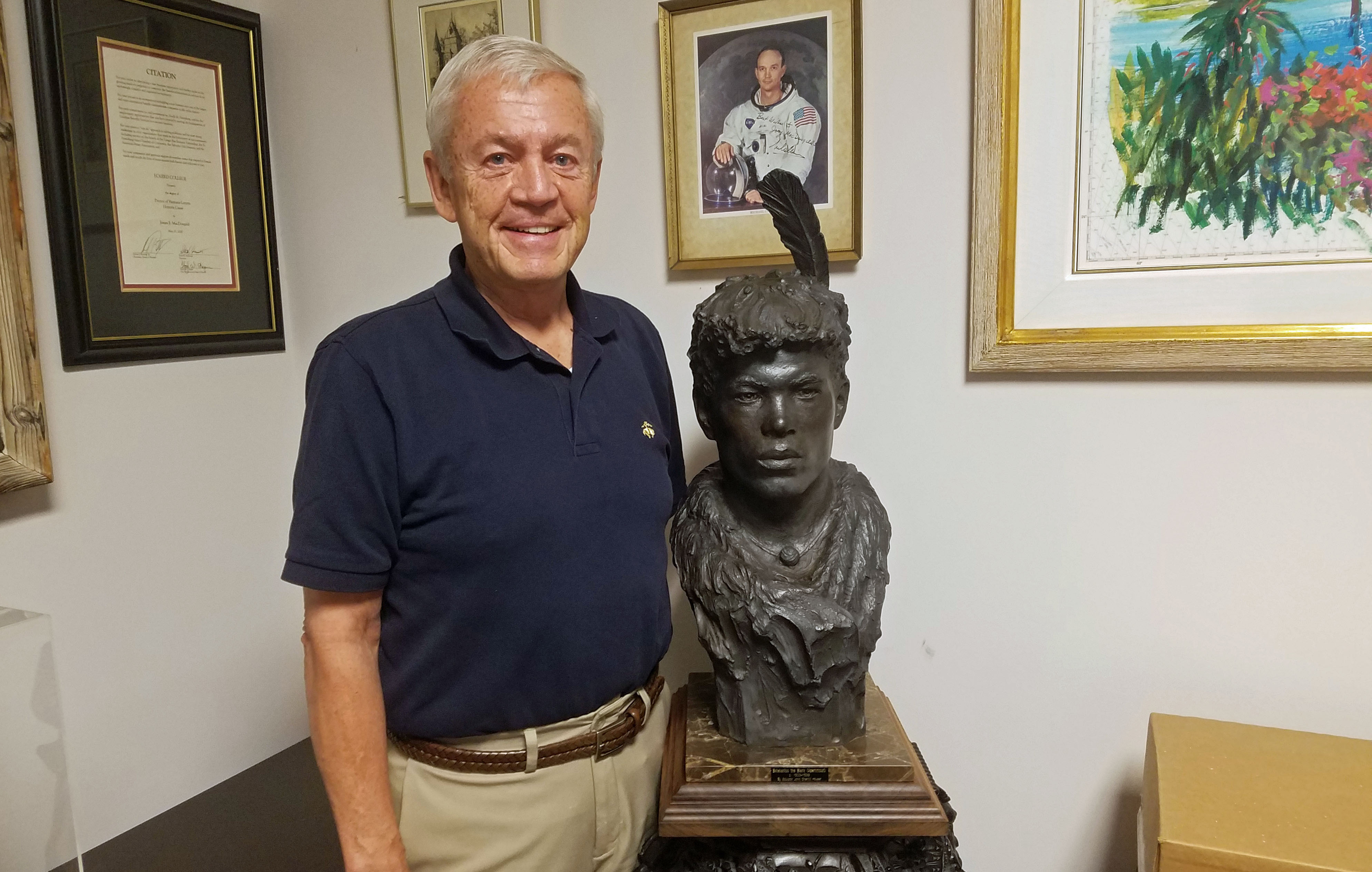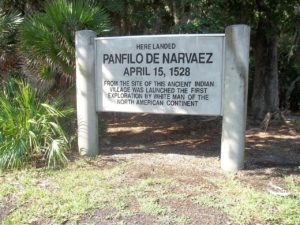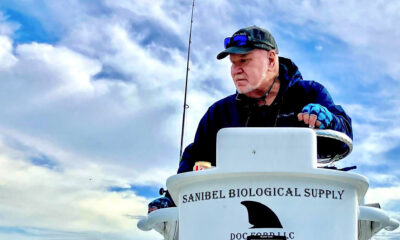New nonprofit puts St. Pete history front and center

At the weedy intersection of Park Street and Elbow Lane, in a region of northwest St. Petersburg known as Jungle Prada, a nondescript white sign announces that Panfilo de Narvaez, the Spanish conquistador and explorer, landed there in 1528. Narvaez launched the first inland exploration of North America – by white Europeans – from the site.
Erected in 2003, when Jungle Prada was added to the National Register of Historic Places, the sign replaced another, even smaller marker, one that had been there for decades. Barely visible from the street, the sign misspelled the great adventurer’s name as Pamfilo.
That sort of casual disregard for history galls James E. MacDougald. The retired business executive (he sold his company, ABR Information Services, Inc., to Ceridian in 1999) is passionate about the past, and is the author of the recently published The Panfilo de Narvaez Expedition of 1528, subtitled Highlights of the Expedition and Determination of The Landing Place.
The subtitle is significant. There’s always been doubt, MacDougald explains, about the exact location where Narvaez and his 300 men came ashore. More than 100 books have been written about the journey. “Out of 35 books that specifically say where he landed, five of them say in or near Tampa Bay,” he says. “Three say Sarasota Bay. All the rest say Boca Ciega Bay – 15 miles north of the entrance to Tampa Bay.”
The party, which was originally bound for Mexico, carried a compass but no telescope (the device had not yet been invented). Only four men remained when the expedition came to a halt eight years and 4,000 miles later. Among these was Alvar Nunez Cabeza de Vaca, an agent of the Spanish king. De Vaca later wrote a book, The Account and Commentaries – the first written descriptions of the New World.
 Through careful analysis of period and contemporary maps, Cabeza de Vaca’s words and descriptions of the terrain, an understanding of navigation as it existed in 1528 and the science of tides, currents and the slow movements of water bodies, MacDougald figured it out: The Narvaez party did, indeed, come ashore at Boca Ciega Bay, on or near the Jungle Prada site.
Through careful analysis of period and contemporary maps, Cabeza de Vaca’s words and descriptions of the terrain, an understanding of navigation as it existed in 1528 and the science of tides, currents and the slow movements of water bodies, MacDougald figured it out: The Narvaez party did, indeed, come ashore at Boca Ciega Bay, on or near the Jungle Prada site.
“So the purpose of the book,” he says proudly, “is to put to rest speculation that it didn’t happen here.”
With that accomplished, MacDougald – a seasoned world traveler with a fondness for historically-significant places – turned his attention to St. Petersburg, his adopted hometown, and the way it promotes its history.
He’s formed a nonprofit called the History Council, with the goal of “re-defining this area as a Cultural Heritage Destination.”
The first thing that has to go, insists MacDougald, is the one-size-fits-all designation “Tampa Bay.” From Charlotte Harbor to Tarpon Springs, the area, he says, should be re-branded The Florida Suncoast. “If you go online and look at Visit Tampa Bay, all you see are Tampa things,” he points out. “You don’t see any place else.”
‘Affluent travelers aren’t going to the beach’
Admittedly, it’s difficult to attract visitors to a tiny sign and a smear of dirt. MacDougald is proposing a monument be created for the Narvaez site, which is adjacent to the “Sacred Lands” Indian shell mound (evidence that a native civilization existed there), and a larger one for the downtown waterfront.
The History Council is also working with the Flight 2014 group to put up a statue (with accompanying educational panels) commemorating the first scheduled airline flight, which took a single passenger from St. Pete to Tampa on Jan. 1, 1914.
There are several other historical milestones on MacDougald’s watchlist.
“‘We’re not trying to say we’re ‘about’ the Narvaez expedition,” he explains. “That isn’t it. St. Petersburg and its environs have done a terrible, terrible job of bringing to the top things that are really significant, historically. The birth of commercial aviation happened in St. Petersburg!”
The city, he points out, is marketed as one very big beach. “We’re drawing people that want to go to the beach,” he says. “We’re not drawing people who want cultural, educational, historic experiences. There’s X amount of people who want to go to the flupping beach!
“The history of the area is really significant. It is a destination in itself. If you don’t care about the beach, it’s worth going to. We have some of the best beaches in the world. We promote the hell out of them, and we should.”
Still, “I’ve traveled a lot. All over the world. And here’s what I know – affluent travelers in their 50s, 60s, whatever, they aren’t going to the beach. They’re looking for places to go.
“They’ve been to San Francisco, they’ve been to Chicago, they’ve been to London, what’s next? We have an opportunity to take this place and say it’s a destination worth visiting. Look at all we’ve got to offer, historically and culturally.
“And by the way, we’ve got some great beaches.”
A sense of place
MacDougald’s unbridled enthusiasm for area history caught Amy Harriett Miller’s attention. A business consultant who worked for a decade in the Dali Museum’s development office, she was unable to find a flaw in his argument.
“We started talking about our love of this region, and how we were frustrated with how it was being marketed,” says Miller, the History Council’s executive director. “So even though we’re a history nonprofit, we have this over-arching mission to market the region properly. As Jim says, if you’re in London and you Google Tampa Bay, you’re not going to find anything about tall these cool local heritage attractions … well, they’re not really attractions, because there’s nothing to look at … yet.”
Give them time. The group, which has an impressive advisory board packed with national, regional and local professors, authors and enthusiasts, has a plan.
“It’s very difficult to market history and historical events, so our aim is to popularize them,” Miller explains. “Take these stories, boil them down with the help of the experts on our advisory board, make them simple, and digestible, and have shorter versions available for the public.”
Books, pamphlets, flyers, films and more will be distributed in schools and museum stores.
Coming Oct. 27 and 28 is the first History Council Symposium, Pre-Columbian and Early Colonial Florida, focusing on the west central Florida area. A dozen distinguished historians and teachers will speak at the event, held at the St. Petersburg Yacht Club.
Included, on the second day, will be a personalized tour of the Narvaez site. Such as it is.
 The bottom line, according to MacDougald, is to put the city’s historical firsts on the same well-lit pedestal as its cultural gems. “We have eight museums in St. Pete, two of them world-class,” he says. “The biggest of their type in the world.
The bottom line, according to MacDougald, is to put the city’s historical firsts on the same well-lit pedestal as its cultural gems. “We have eight museums in St. Pete, two of them world-class,” he says. “The biggest of their type in the world.
“The art world knows about the Dali Museum, but the tourist world doesn’t. Even if they did, would they come all the way from Spain to see eight of Dali’s masterworks? Maybe. Would they come all the way to see where Cabeza de Vaca began the first inland exploration of the United States, and the Dali Museum? Yes, they would.”
He brings up Plymouth Rock on the Massachusetts coast, purportedly where the Pilgrims landed in 1620. “One million people a year – one million – visit Plymouth Rock,” McDougald explains. “Every school child knows about the Pilgrims. It’s not a complete fabrication – they landed somewhere near there – but you can’t engage people in the telling of history without a sense of place. That’s what gets their attention.
“We’re saying you’ve got to create a sense of place in order to tell the story. The Narvaez site is our Plymouth Rock – come here and hear the story. Because it’s a hell of a story.”








Chuck Egerter
September 13, 2018at10:04 pm
Fabulous. Great job James! He can we help!